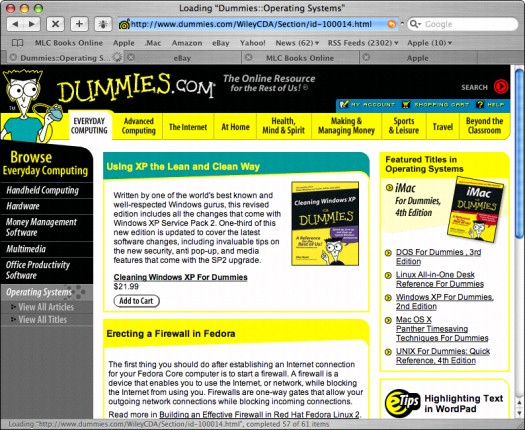With OS X El Capitan, the best browser for your Mac brings new tools for better surfing. Now Safari lets you keep favourite websites open and accessible with Pinned Sites. You can quickly mute audio without hunting for the tab it’s coming from. And use AirPlay to stream video from a web page to your HDTV.
How to get updates for macOS Mojave or later
If you've upgraded to macOS Mojave or later, follow these steps to keep it up to date:

- Choose System Preferences from the Apple menu , then click Software Update to check for updates.
- If any updates are available, click the Update Now button to install them. Or click ”More info” to see details about each update and select specific updates to install.
- When Software Update says that your Mac is up to date, the installed version of macOS and all of its apps are also up to date. That includes Safari, iTunes, Books, Messages, Mail, Calendar, Photos, and FaceTime.
To find updates for iMovie, Garageband, Pages, Numbers, Keynote, and other apps that were downloaded separately from the App Store, open the App Store on your Mac, then click the Updates tab.
To automatically install macOS updates in the future, including apps that were downloaded separately from the App Store, select ”Automatically keep my Mac up to date.” Your Mac will notify you when updates require it to restart, so you can always choose to install those later.
How to get updates for earlier macOS versions
If you're using an earlier macOS, such as macOS High Sierra, Sierra, El Capitan, or earlier,* follow these steps to keep it up to date:
- Have a quick glance on five newest articles on your dashboard. On your OS 10.4 dashboard. Simply.in your Safari Browser. Results in Safari Set the.running Mac OS X 10.7 Lion. Less specific results (673 results) Vivaldi Free. A hyper-customizable and does not track you.
- Apple on Monday introduced the new Big Sur version of its MacOS operating system for its laptops and desktops, with a big focus on updating the Safari web browser. The announcement came during.
- Mac OS X & macOS names. As you can see from the list above, with the exception of the first OS X beta, all versions of the Mac operating system from 2001 to 2012 were all named after big cats.
- Before you start, check the version of Safari running on your Mac. To display the version number, choose Safari About Safari. If your Safari version is 11.0 or later, follow the steps in For Mac OS X 10.11, macOS 10.12, and later. If your Safari version is 10.0 or later, follow the steps in For Mac OS X 10.10.
- Open the App Store app on your Mac.
- Click Updates in the App Store toolbar.
- Use the Update buttons to download and install any updates listed.
- When the App Store shows no more updates, the installed version of macOS and all of its apps are up to date. That includes Safari, iTunes, iBooks, Messages, Mail, Calendar, Photos, and FaceTime. Later versions may be available by upgrading your macOS.
To automatically download updates in the future, choose Apple menu > System Preferences, click App Store, then select ”Download newly available updates in the background.” Your Mac will notify you when updates are ready to install.
* If you're using OS X Lion or Snow Leopard, get OS X updates by choosing Apple menu > Software Update.
How to get updates for iOS
Learn how to update your iPhone, iPad, or iPod touch to the latest version of iOS.
Learn more
- Learn how to upgrade to the latest version of macOS.
- Find out which macOS your Mac is using.
- You can redownload apps that you previously downloaded from the App Store.
- Your Mac doesn't automatically download large updates when it's using a Personal Hotspot.
Apple has released Safari 5, the latest version of its standard web browser for Mac OS X. Also available on Windows platforms, the new browser adds a feature called Safari Reader, which enables the user to read single and multipage articles on the web in scrollable view without any additional content or clutter such as ads.
Just before WWDC10, a French website claimed to have obtained the actual release notes not only for Safari 5, but also for Mac OS X 10.6.4, the fourth incremental update to Apple’s Snow Leopard operating system. While the latter hasn’t been released yet, Safari 5 was officially released hours after the event. All the rumored features are now confirmed as available in the browser. Among other key additions mentioned by Apple is the ability to choose Google, Yahoo and now Bing, as the search service powering Safari’s search field.
Safari 5 on the Mac runs JavaScript 30 percent faster than Safari 4, Apple claims. That’s three percent faster than Chrome 5.0, and over twice as fast as Firefox 3.6, according to Apple’s benchmarking. It loads new webpages faster using Domain Name System (DNS) prefetching, and improves the caching of previously viewed pages to return to them more quickly, an immediately visible change for those who’ve downloaded and used the new version.
Apple Mac Os X 10.9 Download

Newest Safari For Mac Os X64
Adding over a dozen powerful HTML5 features, Safari 5 allows web developers to create new, media-rich experiences, including full-screen playback and closed captions for HTML5 video. Apple has a nifty demo of these new features on its website, as reported a while back.
Finally, Cupertino mentions the new Safari Developer Program. Devs can sign up for free and start customizing and enhancing Safari 5 with extensions based on standard web technologies like HTML5, CSS3 and JavaScript, Apple claims. Also new on the developer front is the Extension Builder, which simplifies the development, installation and packaging of extensions. Security and stability have also been reinforced through sandboxing.
Download Safari For Mac 10.6.8
“Safari continues to lead the pack in performance, innovation and standards support,” Philip Schiller, Apple’s senior vice president of Worldwide Product Marketing, said. “Safari now runs on over 200 million devices worldwide and its open source WebKit engine runs on over 500 million devices.”
Comments are closed.